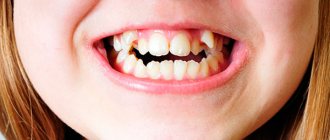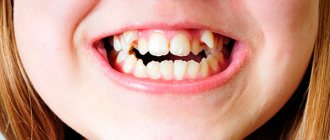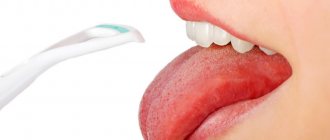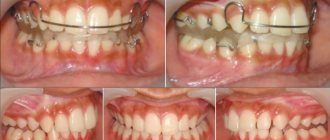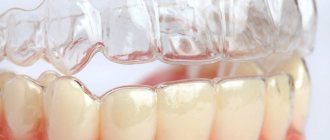Swallowing is a complex set of motor reactions that move food from the mouth through the esophagus to the stomach. The swallowing reflex is innate. It is important to note that during the correct act of swallowing, the tip of the tongue should normally rest against the anterior third of the hard palate.
A child is born with a well-developed swallowing mechanism, which in the first months is called infantile . Due to the contraction of the muscles of the lips, cheeks, and tongue during sucking, negative pressure is created in the baby’s mouth and milk enters the mouth, and the tongue, located between the toothless gums, directs the milk into the oropharynx. Before the first teeth erupt, this infantile type of swallowing , in which the tongue rests on the lips, is a physiological norm . But as baby teeth erupt, sucking is replaced by chewing, and the child’s type of swallowing changes to somatic . During somatic swallowing, the tongue is located in the anterior third of the hard palate, while the back of the tongue pushes food into the larynx.
If a child constantly consumes liquid or semi-liquid food, despite the presence of teeth, then a full act of chewing is not formed, and the transition from the infantile type of swallowing to the somatic one does not occur. At the moment of swallowing, a child with an infantile type of swallowing places his tongue between the upper and lower rows of teeth, which contributes to the formation of an open bite. In this case, the perioral muscles are involved in the act of swallowing, i.e. the lower part of the orbicularis oris muscle, the mentalis muscle and the neck muscles noticeably tense, which is easy to detect by asking the child to swallow saliva.
An incorrect type of swallowing can also result from:
- Using a long pacifier that occupies the entire mouth of the infant and touches the soft palate, which interferes with the proper function of the tongue, soft palate and pharynx.
— Disturbances also occur when there is a large hole in the nipple, through which milk and milk formulas enter the oral cavity in large quantities, the child choke on the incoming food and can swallow it only after the nipple is removed from the mouth and the food flows out through the corners of the mouth. In this case, the forward position of the tongue, which regulates the flow of milk, can become fixed and cause improper swallowing.
— Chronic tonsillitis and adenoid growths also contribute to the tongue moving forward.
- If a child constantly consumes liquid or semi-liquid food, despite the presence of teeth, then a full-fledged act of chewing is not formed, and the transition from the infantile type of swallowing to the somatic one does not occur.
With the infantile type of swallowing, the child’s tongue gets used to only the simplest movements, so the lingual muscle develops poorly (the tongue is not sufficiently developed and mobile).
INFANTILE TYPE OF SWALLOWING IN CHILDREN article (younger group)
INFANTILE TYPE OF SWALLOWING IN CHILDREN
Observing such children, you can notice that the child puts his tongue between his teeth when swallowing saliva. The main reason for the infantile type of swallowing is prolonged artificial feeding and sucking of a pacifier up to 3 years.
As a rule, mothers of children first encounter the infantile type of swallowing when the child has the first dental problems. During an examination at a dentist or orthodontist, parents learn that the child has an infantile type of swallowing and this will lead to problems with bite, or he already has them. And he recommends working with a speech therapist on this topic. You may ask, what does a speech therapist and the infantile type of swallowing have to do with it? How could this be related? Let's figure it out.
SWALLOWING is a complex set of motor reactions due to which food moves from the mouth to the stomach.
From birth, the child has a well-developed swallowing mechanism. Due to the contraction of the muscles of the lips, cheeks, and tongue during sucking, negative pressure is created in the baby’s mouth, and milk enters the mouth, and the tongue, located between the toothless gums, directs the milk into the oropharynx. This type of swallowing is called infantile. Before teething, this type of swallowing is a physiological norm.
But as baby teeth erupt, sucking is replaced by chewing, and the child’s type of swallowing changes to somatic (“adult”). During somatic swallowing, the tongue is located in the anterior third of the hard palate, while the back of the tongue pushes food into the larynx.
Externally, the infantile type of swallowing in children (not infants) and adults is quite distinguishable:
- first option: if swallowing is incorrect, the tongue is placed between the upper and lower teeth and in the lateral spaces between the teeth.
- second option: during improper swallowing, the tongue does not fit between the teeth, but rests on the lower incisors.
The reasons for the infantile type of swallowing are different:
— LONG-TERM NIPPLE SUCKING: use of a pacifier for more than 1 year after the birth of the child. Up to 10-11 months, sucking is the main function for the baby, however, with the eruption of primary teeth, this function fades away, and chewing becomes the main function. If parents continue to use a pacifier for more than one year, this can lead to a disruption in the change from the infantile type to the somatic type of swallowing.
— ARTIFICIAL FEEDING USING THE WRONG NIPPLE: too long or with a large hole,
- THING SUCKING for a long time,
— VIOLATION OF THE DATE OF ERUPTATION OF MILK TEETH — later than 3 months from the physiological norm.
— EARLY LOSS OR REMOVAL OF FRONT MILK TEETH.
— SHORT FRENALE OF THE TONGUE.
— MOUTH BREATHING in chronic rhinitis, tonsillitis, and also adenoids contributes to the anterior position of the tongue and disruption of the transition to the somatic type of swallowing.
— FREQUENT COLD DISEASES in a child.
— LATE INCLUSION OF SOLID FOOD OR THE ABSENCE OF SOLID FOOD IN THE CHILD’S DIETE, AS WELL AS THE PREMIUMORITY OF LIQUID AND PUREED FOOD IN THE CHILD’S DIETE AFTER THE ERUPTATION OF MILK TEETH, a full-fledged act of chewing is not formed, and the transition from the infantile type of swallowing to the somatic one does not occur.
HOW TO CHECK YOUR SWALLOWING TYPE?
If, after all the baby teeth have erupted, while swallowing your child:
- lips do not close,
- the lips are closed, but at the moment of swallowing the tongue pushes away from the lips, the lips compress, the orbicularis oris muscle contracts,
- the tongue is between the teeth,
- the mentalis muscle is involved, when swallowing you can see dimples on the skin of the chin,
- Neck muscles are involved.
These are signs of the infantile type of swallowing, which means the act of swallowing is impaired!
At the moment of swallowing, a child with an infantile type of swallowing places his tongue between the upper and lower rows of teeth, which contributes to the formation of an open bite.
In this case, the perioral muscles are involved in the act of swallowing, i.e. the lower part of the orbicularis oris muscle, the mentalis muscle and the neck muscles noticeably tense, which is easy to detect by asking the child to swallow saliva.
SIGNS OF SOMATIC (NORMAL) SWALLOWING:
— Lips closed without tension.
— The orbicularis oris muscle is motionless.
— The face is calm, the facial muscles around the mouth are inactive.
— The tongue pushes off the mucous membrane of the palate just behind the upper front teeth.
DO YOU NEED TO CORRECT IMPROPER SWALLOWING?
Certainly! An incorrect type of swallowing, preserved in children over 3 years of age, can lead to malocclusion pathologies (most often, open bite). Incorrect position of the tongue creates an unfavorable orthodontic situation in the mouth: distal bite, anterior and lateral open bites, underdevelopment of the upper jaw and advanced development of the lower jaw, narrowing of the hard palate, since the tongue ceases to perform a supporting function.
Let me make a reservation that the main cause of malocclusion may not necessarily be the tongue. There are also hereditary factors! But, if the orthodontist is faced with an infantile type of swallowing, then it is advisable to send such a patient to a speech therapist to check the working parameters of the tongue.
Why is this necessary if the wrong position has become habitual? The fact is that the tongue, as a powerful muscular organ, can “ruin” the work of the orthodontist. This won't happen right away. 1-2, perhaps 3 years will pass, and the new bite created with such great efforts will begin to “creep”. And the reason may be improper functioning of the tongue.
Stable treatment results are obtained by combining treatment with specialists from the orthodontic department of dentistry in combination with classes with a speech therapist.
It is important to remember that if you swallow incorrectly, the chewing process also suffers. The patient may experience pain in the TMJ, cervical spine, occipital, temporal and frontal areas of the head.
THE QUESTION ARISES: “HOW CAN YOU CORRECT INFANTILE TYPE OF SWALLOWING?”
A new way of swallowing, that is, somatic, will be helped by a speech therapist who will prescribe a special set of articulatory gymnastics and training exercises. The complex is selected individually, but there are also exercises common to all (see the list below).
TO NORMALIZE THE SWALLOWING FUNCTION, A SET OF MEASURES IS SHOWN:
— Elimination of all possible causes that could lead to the persistence of the infantile type of swallowing (restoration of nasal breathing, adding solid food to the diet, etc.).
— Myogymnastics – special articulation exercises for the muscles of the maxillofacial area, helping to normalize the function of swallowing. Exercises can and should be done before, during and after orthodontic treatment. It is best to start before installing orthodontic appliances. If the case is simple, then the exercises are performed for 10-15 minutes daily for 1.5-2 months. During scheduled classes, the speech therapist corrects the technique of performing exercises, introduces additional exercises into the complex to consolidate the necessary skills, and conducts speech therapy massage of the tongue.
— Use of orthodontic devices with a tongue rest (for example, MUPPY plates, vestibular plate with bead, myofunctional trainers). A trainer is very effective for correcting infantile swallowing. With each swallowing movement, the tongue of the apparatus reflexively reminds the child of the correct position of the tip of the tongue, which is reinforced during night wear and contributes to the transformation of the infantile type of swallowing into the somatic one. There are contraindications, consultation with a specialist is required.
— Using kinesio taping to normalize the act of swallowing
You can use different schemes with all types of tapes. Using the taping method, you can influence muscle groups involved in the act of swallowing: maxillofacial muscles, muscles of the pharynx, muscles of the sublingual region.
ALL EXERCISES CAN BE DIVIDED INTO TWO TYPES OF EXERCISES:
- Dynamic, when alternating contraction and relaxation of muscles occurs.
- Static, when the muscles are in a state of constant tension.
RULES OF MYOTHERAPY:
— Exercises must be carried out systematically.
— The load should be sufficient (exercises should be carried out until you feel slightly tired).
— The load on the muscles should be increased gradually, but it should not be excessive.
- The number and duration of exercise should increase over time.
CONDUCTING CLASSES. The lesson should be divided into three stages:
— The initial stage is a warm-up, which includes breathing exercises. This is a kind of preparation of the child for the main part; its duration is 2-3 minutes.
— The main part, during which a set of exercises is performed on the muscles of the maxillary-masticatory area. Sometimes special devices are used (for example, standard vestibular plates). First, static exercises are carried out, then dynamic ones. In this case, it is necessary to control that the child maintains correct posture and breathes through his nose.
— The final stage, during which the load is gradually reduced.
EXERCISES FOR TONGUE MUSCLES:
— Running the tongue along the middle of the hard and soft palate, starting with the front teeth.
— With your mouth open, you need to run your tongue first along the upper, then along the lower lip (clockwise and vice versa).
- Gargling with water (this massages the muscles of the soft palate).
— A rubber ring (6-8 cm in diameter) is put on the child’s tongue, after which he is asked to lift his tongue and press it against the hard palate (in the anterior region). After this, you need to swallow the saliva without changing the position of the tongue.
EXERCISES FOR THE ORIBULUS ORIFISH MUSCLE:
- Blow soap bubbles, a balloon or blow on easily moving objects (for example, cotton wool, a piece of paper).
- Press the ruler tightly with your lips, gradually loading it over time.
— Exercise with a vestibular plate - such a plate is placed in the vestibule of the mouth, after which the child squeezes it tightly with his lips, and the adult tries to get the plate out with little effort. The child holds the plate with his lips, resulting in tension in the orbicularis oris muscle.
A COMPLEX OF EXERCISES FOR INFANTILE TYPE OF SWALLOWING
All exercises are performed in front of a mirror, keep your head straight, shoulders slightly back and slightly lowered, chest straightened, stomach tucked, knee joints bent, legs and heels together. The exercises are performed at a slow pace on a count of 1-2-3-4 and repeated 15 to 30 times daily. Exercises to normalize swallowing function:
Exercise No. 1. The child raises the tip of the tongue upward and presses it to the anterior part of the hard palate, clenches his teeth, closes his lips (initial position). Ask him to swallow saliva without changing the position of the tip of his tongue. If the tongue is between the teeth, then the exercise is performed incorrectly. On day 1 5-6 repetitions, on day 2 - 2 times (morning, evening) 5-6 times. In the following days - 3 times a day, 10-12 times.
Exercise No. 2. The starting position is the same. Only now your child must hold his tongue in this position for 5 minutes. On subsequent days, the exercise time is increased to 10 minutes.
Exercise No. 3. The starting position is the same. Now you will teach your child to swallow correctly, without lifting his tongue from the palate, ask him to swallow saliva with his lips closed. The exercise is repeated 3 times a day, 10 times. In this case, you need to ensure that your lips are relaxed.
Exercise No. 4. Half-open your mouth, lick your upper and lower lips, running your tongue from one corner of your mouth to the other. Try to reach the nasal septum and chin with your tongue. Run the tip of your tongue along the lingual and then along the vestibular surface of the teeth, as if counting them, click your tongue, to do this, suck your tongue with your lips closed to the hard palate, and, slowly opening your mouth, rest the tip of your tongue on one or the other cheek.
Exercise No. 5. Smile, open your mouth wide. Raise your tongue up and place it at the anterior part of the hard palate, then move it along the arch of the hard palate in the anterior part and as far back as possible to the soft palate. That is, use the wide tip of your tongue to stroke the palate from the teeth to the throat. The lower jaw should not move.
Exercise No. 6. Click the tip of your tongue like a horse clicking. The mouth is open, the tip of the tongue is not extended or pointed. Make sure that it does not tuck inward and that the lower jaw remains motionless. Perform 50-60 times.
Exercise No. 7. Clench your teeth, close your lips, rest the tip of your tongue on the hard palate - in the projection of the roots of the central incisors, swallow saliva.
Exercise No. 8. “Yawn, chew, swallow.” Throwing your head back: imitate chewing movements, yawning, chewing and swallowing with your mouth closed.
Exercise No. 9. Use an exercise with a pencil - place a pencil across the dentition and hold it with clenched teeth. The tip of the tongue is moved either above or below the pencil.
EXERCISE No. 10. Draw “circles” and “squares” alternately on the hard palate with the tip of your tongue 15-30 times.
HOMEWORK - gnaw, chew, swallow solid food - carrots, apples, meat, crackers, bagels, dry bread... but always under the supervision of an adult!!!
Dysphagia in the elderly
Biyarslanova Raisa Mavladinovna Therapist,
More about the doctor
Dysphagia , or the inability to swallow anything, is a symptom of a number of diseases and is diagnosed in more than 12% of elderly and senile people. This pathological symptom develops against the background of some chronic diseases of the gastrointestinal tract, central and peripheral nervous system. Treatment after an accurate diagnosis can be either constructive or include surgical intervention. In most cases, the prognosis is moderately positive.
Pathogenesis and causes of dysphagia
The reasons that make it difficult for a bolus of food to pass through the pharynx through the esophagus into the stomach are divided into several types. If dysphagia of the pharynx is observed, they speak of oropharyngeal disorders, if of the esophagus - gastroesophageal disorders. Depending on the etiology there are:
- causes of mechanical compression of the esophagus or pharynx - rapid growth of benign or malignant tumors, some forms of tonsillitis, diphtheria, immediate allergic reactions (anaphylactic shock, Quincke's edema), pathologies of the thyroid gland, destructive diseases of the musculoskeletal system (cervical and thoracic spine), blockage of the pharynx or esophagus by any foreign object, etc.;
- disruption of the innervation of the pharynx and/or esophagus - cerebral stroke, and Alzheimer's disease , other neurodegenerative diseases.
The development of dysphagia in the elderly can follow both obstructive and dysregulatory paths. Sometimes a combination of these two branches of pathogenesis is observed. Swallowing disorders caused by mechanical compression of the esophagus or pharynx, or a foreign body entering the lumen, often require surgical intervention. Disturbances in the regulation of smooth muscle tone, which is responsible for the process of moving food from the pharynx to the stomach, require conservative treatment. In any case, therapy aimed at eliminating symptoms is not effective without addressing the root cause - the disease that provoked the occurrence of dysphagia.
Symptoms of dysphagia in the elderly
If a patient consults a doctor with complaints of difficulty swallowing solid food, discomfort that occurs while eating, the specialist will diagnose the 1st (initial) phase of dysphagia. Without adequate therapy, the patient's condition worsens, swallowing liquid becomes difficult, and dysphagia progresses to stage 2. At stage 3, the ability to swallow saliva is lost. Stage 4 is characterized by a complete absence of the swallowing reflex and the ability to swallow anything.
Associated symptoms include a sore throat, inflammation in the pharynx or esophagus, a dry persistent cough without an increase in overall body temperature, and hoarseness. A dull, moderately intense pain may appear.
Diagnosis and treatment of dysphagia
The diagnosis is made and clarified using the following instrumental methods of analysis: pharyngoscopy, x-ray of the esophagus, esophagogastroscopy, pH-metry (daily). To assess the state of the central nervous system, computed tomography or MRI is performed.
The treatment regimen for swallowing disorders without surgical intervention includes taking calcium channel blockers (to relieve spasms), nitrates (have a relaxing effect), and antisecretory agents. For diseases of the central nervous system, as well as during the period of rehabilitation after strokes, neuroprotectors and drugs that improve cerebral circulation are prescribed.
If the cause of dysphagia is muscle dysfunction, special exercises are prescribed to make the muscles work correctly.
Regardless of the cause of the disease, patients need to adhere to the rules of proper nutrition and eat small portions. You can't eat it dry.
In some cases, dysphagia can only be eliminated surgically. If surgery is refused, the prognosis becomes strictly unfavorable with a high probability of death.

